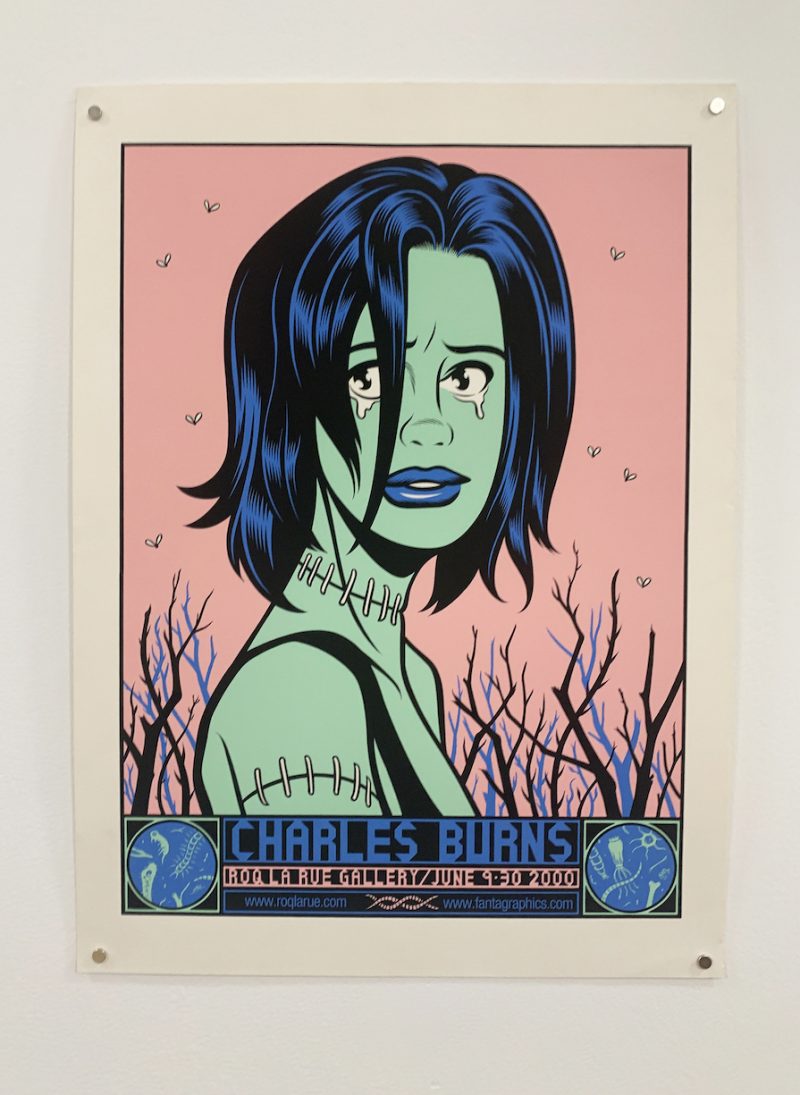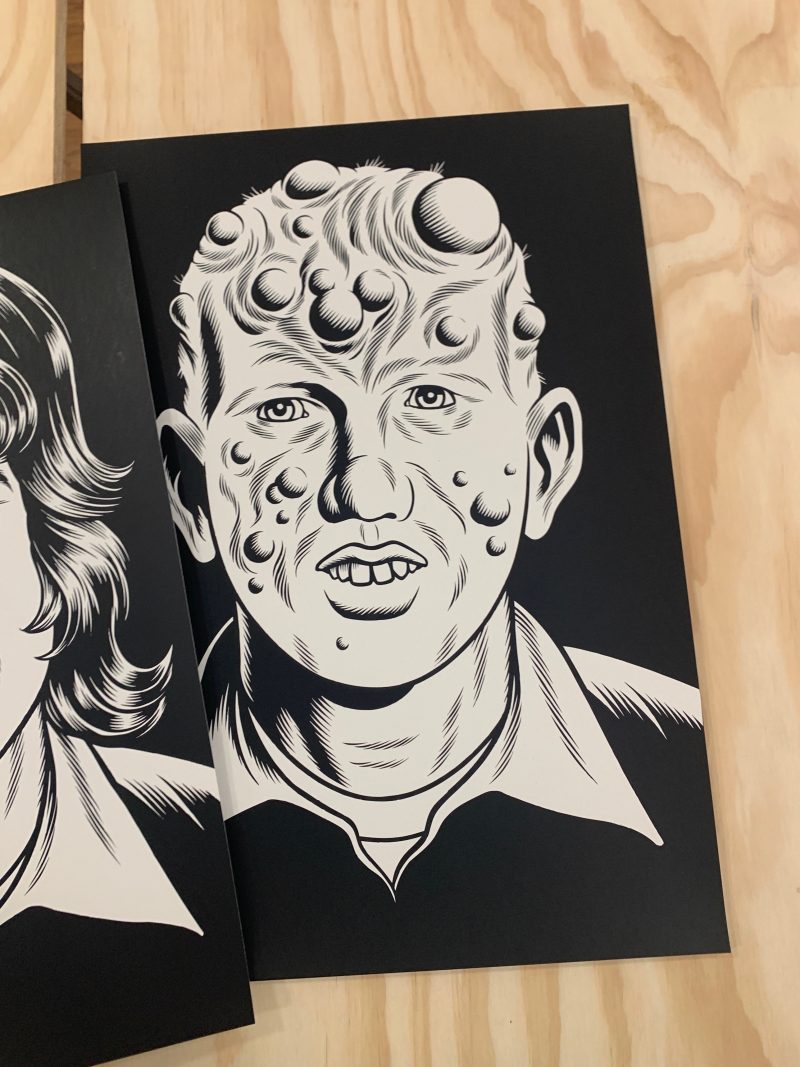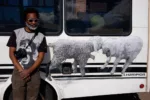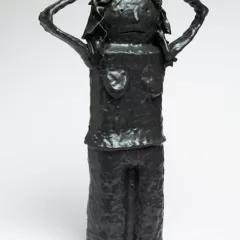
A few weeks ago, Tom Marquet and Gina Dawson repainted the walls at Partners and Son. The walls looked fine before, but Marquet and Dawson, the eponymous partners behind Philly’s only indie-comic-store-plus-art-gallery, are preparing the space for a special guest, and fine was not good enough. On September 9, Partners and Son will open an exhibition of posters and prints by Philadelphia-based cartoonist Charles Burns.

Burns is best known as the writer and illustrator of Black Hole, a gorgeous and disturbing comic series, later collected as a graphic novel, about a group of teenagers dealing with the spread of a mysterious STD. Set in suburban Seattle in the 1970s, the story is rendered in Burns’ characteristic inks, which look like something of a cross between a woodblock print and a 1950s romance comic. Many indie comics fans, myself included, can trace their obsession with the medium back to Black Hole.
Born in Washington, D.C., and raised in Seattle, Burns attended Evergreen State College alongside cartoonists Matt Groenig and Lynda Barry. After art school he moved to New York and became an early contributor to RAW, the comics anthology magazine founded by Françoise Mouly and Art Spiegelman in 1980. He is as close as one can be to indie comics royalty.
For Dawson and Marquet, and for their gallery, this exhibition is important. When the pair opened Partners and Son on September 13, 2019—a Friday and also Dawson’s birthday—they had already been thinking for a few years about opening a “gallery slash comic shop.” They first conceived of the idea while living in Brooklyn, where they were involved in a few artist-run spaces, but it wasn’t until they had left behind New York and its stratospheric rents that it began to seem realistic. “When we came here and we realized we could get a storefront, I think that kind of shifted things pretty dramatically,” Marquet told me.

The shop began as more of a personal project than a moneymaking venture; Marquet and Dawson knew a few cartoonists in Philadelphia, but they weren’t yet sure there would be a market for the sort of art zines, experimental comics, and small-press books they wanted to sell. “I’m a sculptor, Tom’s a cartoonist, this is this kind of dream combo of, ‘Let’s make a gallery slash comic shop,’” Dawson said. “But the comics in it are not necessarily like gonna pay the rent.”
Pretty soon, though, they realized they had found a niche. “We’re filling a hole here,” Dawson said. Local cartoonists started stopping by regularly, and a community cohered around Partners and Son. One of those local cartoonists was Burns. “The first time he came into the shop,” Dawson recalled, “Tom texted me and said, ‘Charles Burns is here.’ And I was like, ‘Just be cool.’”
An hour later Marquet texted back, “I was not cool.”
Marquet grew up on X-Men and Teenage Mutant Ninja Turtles but soon stopped buying them, “‘cause comics cost money and library books were free.” For a decade or so he stuck to novels. And then, when Marquet was an undergraduate majoring in English and studio art, his painting professor invited Burns to give an artist talk. Burns was working on Black Hole at the time; he showed the students pages from the comic and talked to them about its “object-ness.” It was, for Marquet, “a eureka moment.” He realized that comics could be more than superheroes in suits; that, in fact, they could be just as powerful as the fine art and literature he was studying in his classes. After that, Marquet discovered a surprisingly well-stocked comics section at his college bookstore and read everything he could get his hands on. Dawson met Marquet a few years later, in graduate school. She remembers him telling her early on that she had to read Black Hole. “It was basically a prerequisite to date,” she said.
It is reasonable to assume, given this history, that Partners and Son might not exist today were it not for Burns and Black Hole. That’s why Marquet spent a week repainting the shop: “It feels like a big deal,” he said, because it is a big deal.
Despite its relative gravity, the exhibition, Charles Burns: Posters and Prints, was born of an offhand remark. One day Burns stopped by Partners and Son to drop off some books and prints for the shop’s donation shelf. “He said something about how he might bring us more here and there because he had so many,” Dawson remembers. “And I just blurted out, ‘Well, if you ever want a show!’”
After a few messages back and forth, Burns invited Marquet to his house and opened up the archives. They looked at flat files full of posters and prints going back decades, made for concerts, for comics festivals, for fun. Working from such an extensive pool of material posed a welcome challenge for Marquet and Dawson.
“For us, the curatorial part is selecting what’s going to go on the wall, where it’s going to go on the wall and how we’re going to draw the relationships between those things,” Marquet said. He and Dawson want the show to examine the “larger arc” of Burns’ work, which has, in terms of style and content, varied widely between his early comics and the present. The exhibition will include silkscreens, offset-printed posters, lithographs, and a series of fake comic covers; there will be collaborations with Gary Panter, Patrice Killofer and Art Spiegelman. To accompany the show, Burns put together a zine—a “micro-retrospective catalog”—risograph-printed by Risolve Studio in Lancaster, PA.
Longtime fans of Burns’ work—people like Marquet, Dawson and myself for whom Black Hole was a revelation—will leave the exhibition with a deeper understanding of his art and his recurring visual obsessions. Newcomers, on the other hand, who hear “black hole” and think of the astronomical phenomenon rather than the comic, will surely leave as fans. And everyone, fans and newcomers alike, will be haunted by the grotesque beauty, the seductive weirdness that could not have come from anywhere but Burns’ masterful brush.
Charles Burns: Posters and Prints is on view at Partners and Son, 618 S 6th St., from September 9–October 16. An opening reception will be held on September 9 from 6–9 p.m. Burns’ share of the proceeds from the exhibition will be donated to Philabundance and the Youth Art & Self-Empowerment Project.









